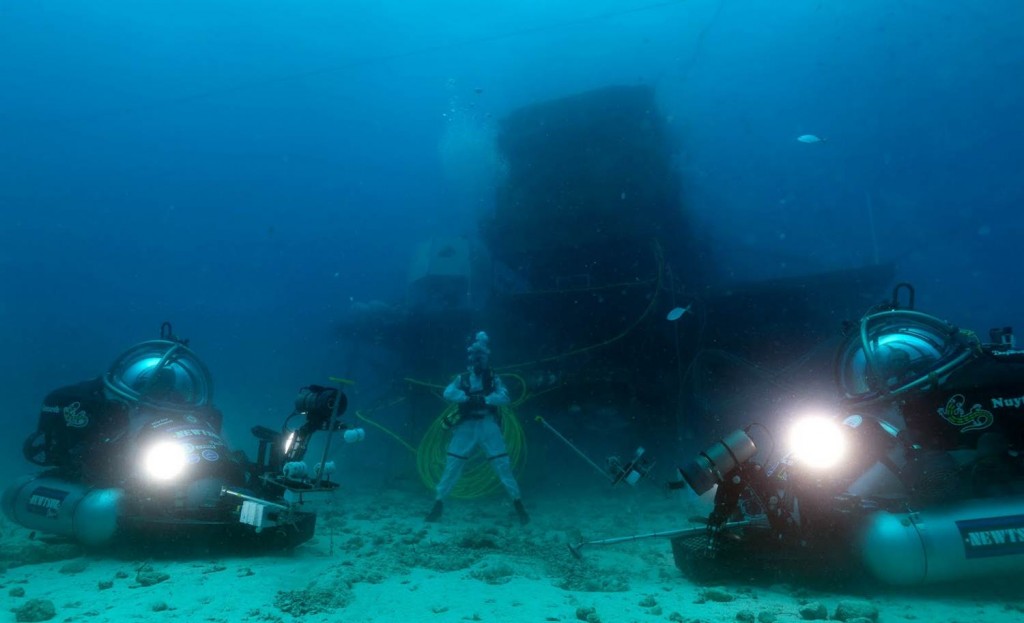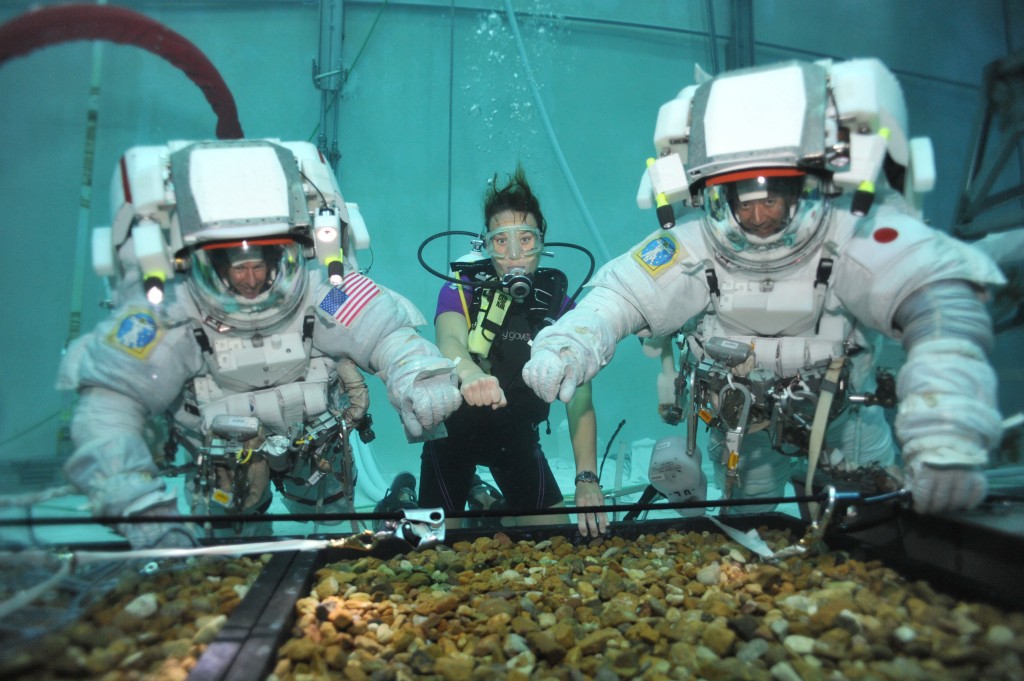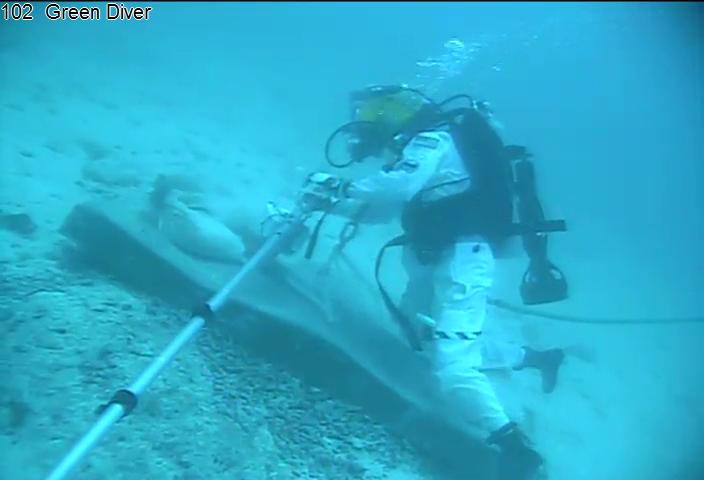Welcome aboard the NEEMO 16 mission!
Destination: Asteroid, deep space
Date: 11-22 June 2012
 Earlier this year I was fortunate enough to be assigned to NASA’s Extreme Environment Mission Operations (NEEMO) 16th mission to an underwater habitat called ‘Aquarius’, which lies about 20m under the ocean and nearly 8 miles off Florida’s Key Largo coast. Over the years, NEEMO missions have been used by NASA to provide vital research and development data to support future exploration missions.
Earlier this year I was fortunate enough to be assigned to NASA’s Extreme Environment Mission Operations (NEEMO) 16th mission to an underwater habitat called ‘Aquarius’, which lies about 20m under the ocean and nearly 8 miles off Florida’s Key Largo coast. Over the years, NEEMO missions have been used by NASA to provide vital research and development data to support future exploration missions.
Living underwater is an excellent space analog – the crew can practice EVA (‘spacewalk’) techniques using neutral buoyancy in water, whilst Aquarius offers an environment similar to a spacecraft: confined living space, total reliance on life support systems and no option for a quick return. The crew can only surface safely after 12 hours of decompression – to do otherwise would risk severe decompression illness or ‘the bends’.
The NEEMO 16 crew comprises NASA astronaut and mission commander Dorothy (Dottie) Metcalf-Lindenburger, JAXA astronaut Kimiya Yui, Professor of Astronomy Steve Squyres and myself. In addition we will be supported by two habitat technicians who are also diving experts. The crew will spend 12 days living in Aquarius, conducting two EVAs each day. Like any space mission, there will be an experienced ground support team who will manage operations, communications and logistics from their Mission Control Centre (MCC) on dry land.
The European Space Agency will also play a key role in NEEMO’s MCC thanks to the support of Hervé Stevenin – a highly experienced EUROCOM (Europe’s voice link to the International Space Station) and EVA/diving instructor at the European Astronaut Centre (EAC). Also supporting the mission will be Ben Douglas, an experienced flight surgeon from EAC’s Crew Medical Support Office.
As if the prospect of living for 12 days underwater wasn’t exciting enough…it gets better! The aim of NEEMO 16 is to simulate a future mission to an asteroid. This is the current focus for NASA’s first manned mission into deep space, venturing beyond the moon’s orbit and once more pushing the boundary of human presence in our solar system.
The Orion spacecraft will be instrumental in getting astronauts to asteroids, launched atop the Space Launch System. For the journey, which could last anywhere between 1-6 months, the crew would likely live inside a Deep Space Habitat and once there they would explore the surface using a Space Exploration Vehicle (SEV). The SEV would take astronauts close to the surface where they could perform EVAs that would involve deploying instruments and collecting samples.
NEEMO 16 aims to study some of the challenges that will be faced during an asteroid mission – how astronauts and SEVs can work together using restraint and translation tools and techniques in order to explore the asteroid surface (particularly difficult in a very low gravity environment), optimal crew size for efficiency and the inevitable communication delay that will increase with distance from Earth.
For this mission our SEVs will be simulated by two DeepWorker submersibles, piloted by fellow astronauts. The subs will be modified with a foot restraint attached to a manipulator arm, which will enable astronauts outside the SEV to hitch a ride as they explore the surface and collect scientific samples. In addition, astronauts conducting EVA will have the opportunity to wear ‘jet-packs’ (battery powered thruster packs) to move quickly and easily from one place to another. Is this beginning to sound like the best birthday present anyone could wish for? Well, I have just turned 40 so thank you, European Space Agency!!
More to follow on the NEEMO 16 mission training in the build up to Splashdown on June 11th!













Discussion: 14 comments
Happy Birthday–I’m 44 in 14 more days, but I’m thinking my party probably won’t include an underwater journey unless I take a bubble bath and go looking for lost soap, so please please please do keep us posted (and take lots of pictures), because this is so interesting –and important–for future space exploration!
So excited for you and your crew mates! Thanks for sharing 🙂
Rhonda
(xoxoroo on twitter-i follow your adventures there, too!)
Hi Rhonda – glad you enjoyed the post and there will definitely be lots more photos, videos, blogs and tweets on NEEMO to follow. During the mission you can also watch us ‘live’ on the webcams from the Aquarius hab. Going to be a great mission… 🙂
Bon anniversaire, Monsieur Peak! Indeed I think every single reader end up with a bit of jealousy after reading such an article.
I am not surprised an astronaut can be an aquanaut (and again this looks like it’s an awesome mission to be assigned to), but why the hell Prof. Squyres is an aquanaut???? What does NASA want by sending him underwater? Makes him a Principal Investigator for a potential mission? How did they choose the crewmembers?
Thank you for the article!
Hi Gabrielle – Prof Squyres has been participating in NASA’s planetary exploration missions since the days of Voyager 1. He’s an awesome guy and amongst many other things is the PI for the Mars Exploration Rovers ‘Spirit’ and ‘Opportunity’ – what he doesn’t know about planetary exploration isn’t worth knowing (you can read more on Wiki – interesting bio!). When doing research and development it’s often a good thing to have crewmembers with diverse backgrounds – it encourages blue skies thinking and challenges the ‘well, we’ve always done it like this before…’ approach!
Thank you very much for the answer; this is good news (hopefully)! So right now I am actually in the MER science team (my advisor is co-PI); does it mean that at some point I can be chosen as an aquanaut if it is related to my research, considering that I am French and not American (and not (yet) an ESA astronaut)?
You are talking about research, so, for you, as an astronaut, are you doing research as well, or this mission is more for training? I thank you very much for having taken time to reply and I thank you in advance for answering these extra questions, hopefully I am not bothering! Thank you!
Hi Gabrielle – NEEMO is great for many things. “16” is primarily a research and development mission to provide data to support the tools, techniques and procedures required for future manned exploration. But of course we also benefit from the great training that goes along with such a mission – from EVA skills, crew interaction, communication protocols, emergency procedures…I could go on and on! As for being chosen as an aquanaut – I don’t know the answer but if it’s what you want to do…go for it 🙂
We are following your exploits with great interest Tim. Excitement is hotting up! Shall be watching out for further news of your latest mission and hope to see you in the Summer?
Tim, it looks as though you are going to clock up as many hours underwater as you have in the air. As this is such a protracted period, is it also designed as a tester for issues like claustrophobia and (…although I’m sure that people will be talking to you all the time on the net…) sensory deprivation and the associated psych effect? Also, what gas mix (ie Nitrox 36) are you using at 20m for that length of time..or is it good ol’ fashioned air? Best of luck and don’t forget to moisturise to avoid crinkly fingertips!
PS sorry about the lack of 40th card. We’ll bake a cake for the next time we see you all.
Hi guys – thanks for the post! I feel like I have spent most of this year training underwater already but definitely no complaints…it’s been a fantastic experience. NEEMO is primarily designed for research and development objectives but as you mention, it is such a great analog to a space environment that we will also benefit from exposure to isolation, confined living spaces, higher risk environment and of course any ensuing psychological effects. In the habitat we’ll be breathing good ol’fashioned air – so we’ll be well and truly saturated after 12 days hence the long decompression. Looking foward to catching up at the Farnborough Airshow 🙂
Reading this now makes me remember how much fun it was to follow the mission progress on Twitter – thank you all SO much for taking time out of your schedules to post pictures and messages… it was an amazing experience knowing that you guys were at the bottom of the ocean! The live streaming was awesome too. When I saw the pictures of the tech setup though, that’s what really made me drool – considering the conditions that you would have to work under if you were probing an asteroid, communication must be of utmost importance! I imagine that if you were actually in space, you couldn’t actually pat each other on the back to get each other’s attention – not only because of the suits, but because it might send the other person flying. Who manages the networking setup at NEEMO? I would have loved to do an internship with them if I was still working in IT!
I’m glad you enjoyed following the mission…we certainly had a great time doing it! You’re absolutely right that communications continue to be one of the most important factors in any mission. The technique that worked best during NEEMO was using an instant messaging tool for comms between Aquarius and Mission Control – although in our case it wasn’t ‘instant’ but had a 50sec delay imposed for simulation. Voice comms were used between the Intra-Vehicular Activity console in Aquarius and the astronauts conducting the EVA, with no time delay. During NEEMO, NASA works closely with the National Undersea Research Centre (NURC) to manage the complex communications and IT network setup.
Even the communications set-up required global collaboration – this must have taken immense effort to co-ordinate, which makes it even more impressive in retrospect 🙂 Instant messaging sounds like the best solution, although did you experience any disadvantages from the 50s delay? Was that to simulate what it would be like if you were further away from the earth (i.e. how long it takes the signals to travel back and forth)?
Epic 😀 I found this site on google poking around for something completely different-
now I’m going to have to go back and go through the archives. So long my free time today, but this was a really great find.
Very charming ….
You managed to convey the wonder and passion with which you have lived this experience.
I await the next adventure Tim 😉